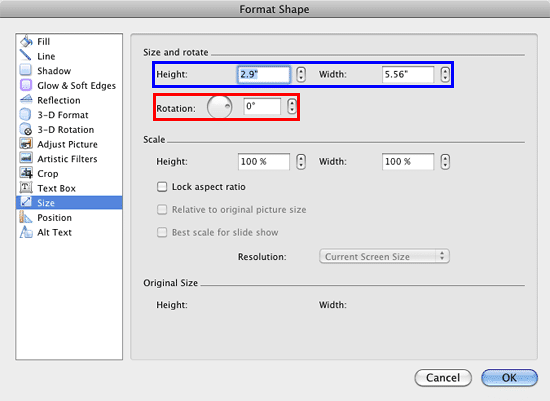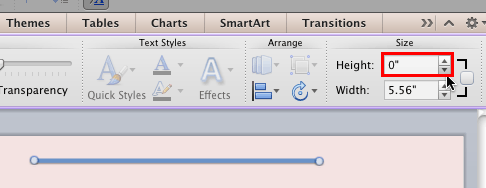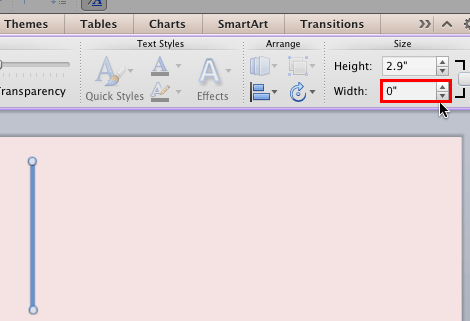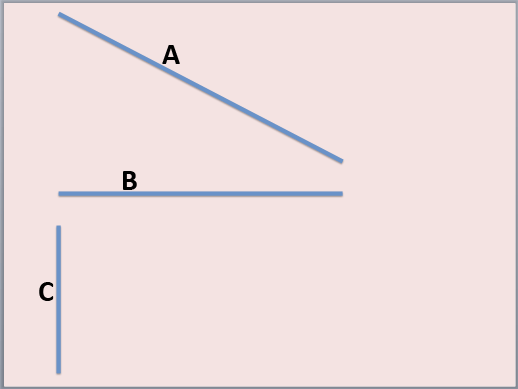Learn how to change a diagonal line to a horizontal or vertical line in PowerPoint 2011 for Mac. You'll have to change either the height or width value to zero.
Author: Geetesh Bajaj
Product/Version: PowerPoint 2011 for Mac
OS: Mac OS X
In PowerPoint, you rotate shapes using the white rotation handle that appears when you select a shape. However, did you ever notice that the open line shape in PowerPoint doesn't show a green rotation handle? Look at Figure 1, below, where you can see a diagonal line on the left and a triangle shape on the right. Both are selected, yet notice that the triangle shape includes a green rotation handle whereas there is no such handle on the Line shape.

Figure 1: An open line shape doesn't have a rotation handle
Now, if you want to rotate any diagonal line such as the one shown in Figure 1, above, how would you do so? Yes, you can right-click (or Ctrl + click) the line to bring up a contextual menu. Within this menu, select the Format Shape option to bring up the Format Shape dialog box, as shown in Figure 2, below. Here you can find the Rotation option, as shown highlighted in red within Figure 2, and type in a value.

Figure 2: Rotation option within the Format Shape dialog box
But as you will notice, even a diagonal line has an initial Rotation value of 0°. So, you really have no clue at this time to determine how much you have to rotate to create a line that's standing vertically or sleeping horizontally! Even though you may think that you hit a dead end, there is a workaround using which you can rotate a Line shape using the Width and Height options, as shown highlighted in blue within Figure 2, above.
Follow these guidelines to learn more in PowerPoint 2011 for Mac:



Yes, now you have rotated your diagonal line. But have you noticed something? Is your line shape retaining its original length even after getting rotated? Unfortunately, it is not! Look at Figure 6, below, which shows a PowerPoint slide containing 3 Line shapes. The line marked as B is the copy of the same diagonal line that resulted from changing the Height to zero. And finally, the line marked as C is the copy of the same diagonal line A, that resulted from changing the Width to zero.

Figure 6: Diagonal line and its copies rotated horizontally and vertically
Look closely at Figure 6, above, and you will notice that both of the rotated lines have lost some length. None of them is of the same length as the original line A. To overcome this drawback, you should know the length of your diagonal line in the first place. But again, there is no specific option in PowerPoint to achieve this! The good news is that we have a workaround for this too!
Find out the length of your diagonal line by following our Finding Length of a Diagonal Line in PowerPoint 2011 for Mac tutorial. Once you have noted down the length value, you can get back the original length of the rotated lines by following these guidelines:
06 02 04 - Advanced Shape Techniques: Change a Diagonal Line to a Horizontal or Vertical Line in PowerPoint (Glossary Page)
Change a Diagonal Line to a Horizontal or Vertical Line in PowerPoint 365 for Windows
Change a Diagonal Line to a Horizontal or Vertical Line in PowerPoint 365 for Mac
Change a Diagonal Line to a Horizontal or Vertical Line in PowerPoint 2013 for Windows
Change a Diagonal Line to a Horizontal or Vertical Line in PowerPoint for the Web
You May Also Like: DesignEvo: Conversation with Henry Wong | Africa PowerPoint Templates




Microsoft and the Office logo are trademarks or registered trademarks of Microsoft Corporation in the United States and/or other countries.